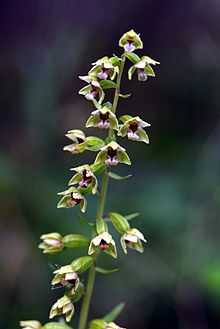Epipactis dunensis
| Dune Helleborine | |
|---|---|
 | |
| Inflorescence, Anglesey sand-dunes | |
| Scientific classification | |
| Kingdom: | Plantae |
| (unranked): | Angiosperms |
| (unranked): | Monocots |
| Order: | Asparagales |
| Family: | Orchidaceae |
| Subfamily: | Epidendroideae |
| Genus: | Epipactis |
| Species: | E. dunenis |
| Binomial name | |
| Epipactis dunensis Godfery | |
| Synonyms[1] | |
| |
Epipactis dunensis - the dune helleborine is an herbaceous member of the family Orchidaceae.
It is hardy and has a long fleshy rootstock. It flowers from June to August with an inflorescence up to 50 cm high. The fruit is a capsule, from which the light, microscopic seeds are spread by the wind.
Dune helleborine is a British endemic species and in Britain limited to three main areas in England and Wales, the sand-dunes of Anglesey, dunes on the Fylde coast and in the valley of the River Tyne where it has colonised old metal mine workings.[2][3][1]
References
- ↑ 1.0 1.1 Kew World Checklist of Selected Plant Families
- ↑ Foley M, Orchids of the British Isles , ISBN 0 954191617
- ↑ IUCN Red List of Threatened Species
External links
- First Nature, Epipactis dunensis - Dune Helleborine
- North Merseyside Biodiversity Action Plan, Dune Helleborine, Epipactis dunensis
- Biopix, Dune Helleborine (Epipactis dunensis)
| Wikimedia Commons has media related to Epipactis dunensis. |